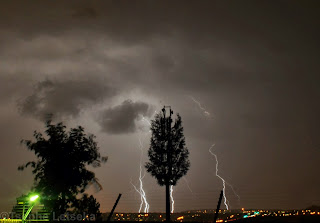Convection. It's a term we hear very often in conversations about the weather, especially pertaining to storms. We hear it a lot in weather forecasts, storm warnings and we read about it in weather journals, books and other weather related publications.
So what is convection? How does it happen? And what role does it play in the development of storms?
The term itself is a general term that has many broad meanings. https://www.vocabulary.com/dictionary/convection
I will be focusing on the weather related side of convection on this post as I am more knowledgeable on that type of convection. From a weather perspective, convection (or more specifically atmospheric convection) refers to the heating of the ground by the sun which in turn heats the air just above it. This then results in a pocket of warm air which rises up into the cooler air above. Upon mixing with the cooler air it condenses and forms clouds. It also release energy in the form of latent heat. The differences in temperature between the warm air and cooler air above leads to atmospheric instability which, if the conditions are just right, will cause the air to expand and lead to the development of cumulus clouds. If there is enough moisture and enough instability is maintained, continued convection will lead to the development of cumulonimbus clouds, the characteristic clouds known to produce thundery weather around the world.
Another commonly used term in weather circles is explosive convection or explosive development. This of course is not really a scientific term but one that is very popular. It refers generally to thunderstorms (not necessarily severe thunderstorms) that develop very quickly, often within a matter of just minutes. Often the vertical movement of the clouds as they rise high into the atmosphere can be visible to the naked eye, giving one an idea of just how strong the convection currents and updrafts are. But the best way to really get an idea of how spectacular an explosively developing thunderstorm is, is by watching it in a time lapse video.
Thunderstorms, at least here in South Africa anyway, develop explosively when there is high heat and humidity resulting in a high level of instability and strong convection. A strong jet stream also helps. In the Highveld region, explosive thunderstorms also develop when these factors are combined with the presence of a dry line boundary or a cold front that provides the lifting mechanism needed for them to develop.
| Meteosat 0-degree Airmass Product, showing convection over southern Africa that typically brings intense (and mercifully brief) storms. Image source: EUMETSAT. |
The satellite image above shows a typical spring and summer weather pattern in South Africa, with intense and explosive thunderstorm activity in the east of the country, while the western part of the country remains largely dry. Taken on the 30 October 2013, it shows intense thunderstorm activity covering the entire Gauteng province, most of Limpopo, Mpumalanga, KwaZulu Natal and small sections of the Northwest Province and the Free State. Such intense and explosive thunderstorm activity is typical for this part of South Africa at this time of the year. Warm moist air from central Africa is drawn south to South Africa where, coupled with the heating of the ground and other factors like the presence of a dry line boundary gives rise to the powerful convection currents that lead to the development of the explosive storms that are typical for this region of the country during the spring and summer.





































